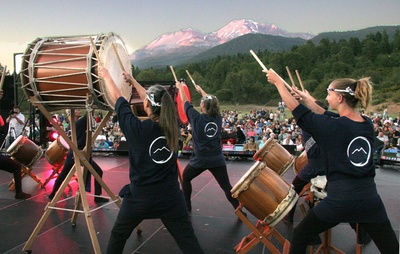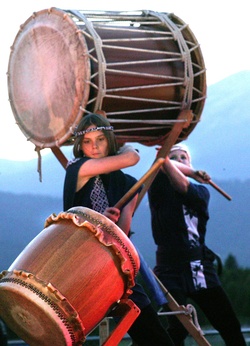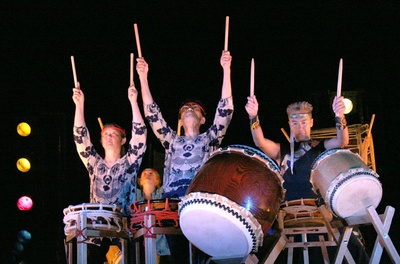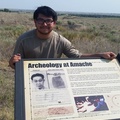ShastaYama (literally, Shasta mountain) is the name of the annual taiko festival held in the beautiful pine-forested town of Mount Shasta nestled at the base of the majestic Mt. Shasta. Mt. Shasta, at 14,162 feet, is often compared to Mt. Fuji for its similar spiritual beauty and size. Mt. Shasta offers different appearances throughout the day with the changes of time of day and weather conditions. Of course the season makes a difference to its appearance as well.
ShastaYama is an outdoor summer evening concert created by Russel Hisashi Baba and Jeanne Aiko Mercer who founded the Shasta Taiko program in 1985. The creation of ShastaYama expanded on a goal of presenting taiko to the area through annual formal concerts. The annual indoor “Shasta Taiko in Concert” was established in 1996 and in 2005 was renamed “ShastaYama” and moved outdoors with a vision of combining a quality arts experience with the pristine beauty of the Mt. Shasta area as a backdrop. The annual showcase was established to provide focus for “Shasta Taiko” students and also present and support outstanding guest artists.
Initially the Shasta Taiko program was formed to teach the Mt. Shasta children the Japanese cultural art of taiko. Masato “Maz” Baba, their then six-year-old son, was among their first students. Mt. Shasta residents Shoji Kameda and his two sisters Tami and Ayumi joined with other local children and under the patient and disciplinary guidance of Russel and Jeanne developed into an exciting and dynamic performing group. An award winning video documentary, “Shasta Taiko” was produced, featuring this accomplished youth ensemble by S. Carol Ono, Russel’s supportive sister.
Today, Maz and Shoji are principal members of Los Angeles based On Ensemble, that includes Kris Bergstrom and Kelvin Underwood. On Ensemble is known for their cutting edge excursions from traditional taiko introducing distinctive electronic and vocal sound enhancements.
Additionally, Maz is the musical director and a teacher with TAIKOPROJECT, a Little Tokyo based taiko performance group that also operates a taiko school. Shoji is a relatively recent member of Hiroshima, a nationally-renown jazz-fusion band, contributing the sounds of taiko, Japanese flutes and voicing.
ShastaYama 2005 featured one of the premier American taiko groups, San Jose Taiko. In 2006, ShastaYama presented Grand Master Seiichi Tanaka and the San Francisco Dojo, influential and recognized founder of the taiko movement throughout the United States.
ShastaYama’s guest artists in 2007 were Kenny Endo, internationally recognized master of Japanese drumming and his wife, Chizuko Endo, who with Kenny, leads the Taiko Center of the Pacific based in Honolulu.
Perennial guest artists for ShastaYama have been former Shasta Taiko members Maz Baba and Shoji Kameda. Joining the Endos, ShastaYama 2007 guests included taiko artists and dancers Michelle Fujii, Portland Taiko’s Artistic Director and former member of the San Jose Taiko, ON Ensemble, and TAIKOPROJECT; and her husband, Toru Watanabe, a member of the renown Warabiza, fork arts troupe in Japan and also a member of Portland Taiko.
ShastaYama 2007, produced with the help of Shasta Mountain Playhouse, was held on a weather perfect August weekend. In the late afternoon and before the magical evening program formally began, local musicians, including a belly dancer performed for the early arriving patrons who came to stake their claims for good viewing spots, to set out their blankets and lawn chairs, and to enjoy a festive picnic meal. A food court, featuring local chef creations, helped to contribute to the leisure and congenial atmosphere.
If you’d like to experience this entertaining concert first-hand, please plan on the beautiful drive to Mt. Shasta.
ShastaYama 2008 is slated for Saturday, July 26, 2008. Come a day earlier and stay a day later to sample the mystical beauty that is Mt. Shasta. There are many nice accommodations if you plan ahead and there’s much to do: hiking, fishing, shopping and dining are some of them. Check out the link for more information: www.shastayama.com
You’ll have a good time. Lisa Shimamoto, a member of Bombu Taiko, a community-based taiko group affiliated with TAIKOPROJECT, made the drive up all the way from Los Angeles along with team member, Cheryl Toyama. When asked about her experience, Lisa said, "Hearing the spirit of the drum against the majestic backdrop of Mt. Shasta was breathtaking. It was a great evening to spend a night out with family and friends while being entertained by Shasta Taiko and special guest artist Kenny Endo, Michelle Fujii and Toru Watanabe. Masato Baba's parents' Russell Baba and Jeanne Mercer were beaming with pride and joy as they watched their son perform with Kenny Endo on a duet piece that had everyone mesmerized. If you get a chance to see the show, it is well worth the trip."

Backstage, before the Shasta Yama 2007 program begins, Russel & Jeanne exercise a tradition they honor before all their performances, forming a circle of spirit to express their appreciation to all the participating artists.
* For more photos of ShastaYama 2007 performances, please visit the ShastaYama 2007 collection in the Nikkei Album.
© 2008 Gary T. Ono












